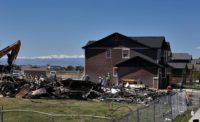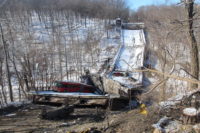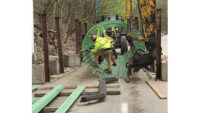NTSB Joins Colorado Gas Blast Probe
The National Transportation Safety Board has opened an investigation into the cause of an April gas explosion in northern Colorado that killed two men who were working on a water heater in a basement and badly injured a third person in the home.
“We are looking at the accident purely from a safety perspective,” NTSB spokesman Keith Holloway told ENR. “It’s too early to determine a cause, but we want to find whether this is an isolated incident or it could have national impact.” The NTSB investigates pipelines because they carry materials.
Local fire officials said after the April 17 explosion that the commercial gas line to the house in Firestone, Colo., north of Denver, had been turned off, but determined the explosion was caused by a buildup of methane and propane gas.
The odorless, colorless gas likely seeped inside through a sump pit and a French drain from an open gas pipeline buried 7 ft below ground and severed only 6 ft from the foundation, officials said. The abandoned line was still connected to a working well owned by Anadarko Petroleum Corp. The well is situated less than 200 ft from the house. Anadarko shut down 3,000 of its vertical wells in northeastern Colorado on April 27, out of “an abundance of caution,” the company said.
An initial investigation found that the switch for the uncapped flowline was open. Officials say a simple pressure test, had one been done, could have shown that the pipe was cut and had not been capped. However, no comprehensive programs are in place to test and monitor pipelines. The Colorado Oil and Gas Conservation Commission, which oversees oil and gas in the state, also admits it doesn’t know where all the pipelines are located.
On May 7, Colorado Gov. John Hickenlooper (D) issued a directive giving oil companies 30 to 60 days to locate and test flowlines within 1,000 ft of any occupied building. Colorado currently maps all oil and gas wells in the state but does not maintain a database of underground pipelines. The governor also ordered that all abandoned pipelines at least 3 ft below the surface be marked, cut and capped.
Meanwhile, one family in the neighborhood where the explosion occurred sued Anadarko, previous well operator Noble Energy and the developer and contractor for the housing development.




